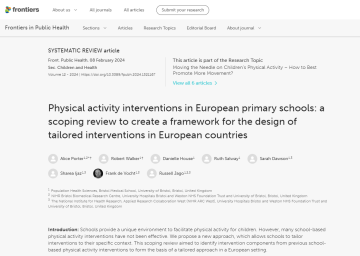Designing tailored physical activity interventions for primary schools
- 8 February 2024
Primary school-based interventions aimed at increasing physical activity among children are usually targeted at physical education (PE) lessons, active breaks and active and outdoor learning, according to a paper published in Frontiers in Public Health. Only one of the studies included in this review paper considered the cost-effectiveness of the intervention, which is a key factor for schools.
The UK Chief Medical Officers recommend that children should be physically active for an hour a day and schools offer a unique environment for them to do this. However, researchers found that school-based interventions are ineffective or have only a small impact on children’s overall activity levels. They argue that this may be down to a lack of focus on the cultural, socioeconomic and environmental context of schools.
Findings from this paper will help the research team continue their work on a project aimed at developing tailored physical activity interventions for primary schools. The PASSPORT study is aimed at working with schools, children and families to develop a menu of physical activity options that schools can choose from to produce their own physical activity programme. This approach will allow schools to tailor interventions to their specific context and needs.
Dr Alice Porter and Dr Rob Walker, lead authors, said:
“During this scoping review we created a framework of intervention component types across 11 activity opportunities: six within the school day, three within the extended school day and two within the wider school environment.
“Most of the intervention components we identified were delivered by school staff. This may be more convenient and cost-effective than relying on external providers but can be unsuccessful due to a lack of time and resources.
“Among the studies included in our review, few provided any context for schools such as geographical location, socioeconomic characteristics, ethnicity, and school size. This made it difficult for us to understand whether context had any impact on the success or design of interventions. Future research should seek to measure and report contextual factors, and to better understand the important aspects of context within school-based physical activity.”
